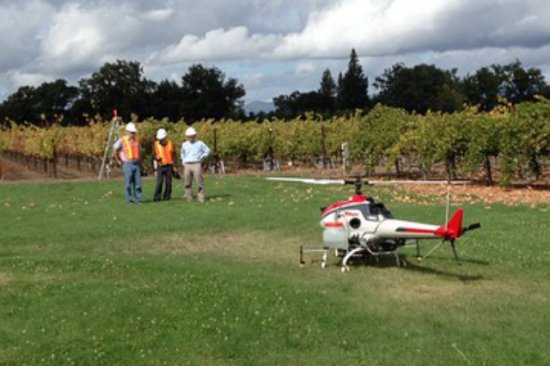The Yamaha Motor Co. is waiting to hear whether the Federal Aviation Administration will grant its RMAX drone a regulatory exemption that will let it operate commercially in certain areas of the U.S. The helicopter has been used in Japan for about two decades to spray crops.
On September 25, U.S. Transportation Secretary Anthony Foxx announced that the FAA has granted the first exemptions for the commercial use of drones to six aerial photo and video production companies for use in Hollywood.
“It was great that the movie industry petition was granted, it gives us hope,” said Steve Markofski, a business planner at Yamaha Motor during Wednesday’s demonstration over vineyards owned by the University of California, Davis.
Currently, FAA regulations effectively prohibit the use of commercial unmanned aerial vehicles, unless an exemption has been granted. Escalating industry demands have prompted FAA officials to begin looking for ways to authorize limited commercial uses of small drones in U.S. airspace. The FAA appears to be considering applications in the order they were received. There are two in front of Yamaha’s request including Trimble Navigation Ltd. which wants to perform precision aerial surveys for agricultural purposes by taking still photographs and VDOS Global LLC which wants to perform inspections in the Gulf of Mexico for a major energy producer.
Because it took the FAA about 120 days to decide about Hollywood, the hope is that it will take about the same amount of time to decide on other exemption requests, said Melanie Hinton a spokesperson for the Association for Unmanned Vehicle Systems International.
The FAA said it is broadening the commercial use of unmanned aircraft systems while maintaining safety. “The agency has received petitions for UAS use in areas such as agriculture, geological survey, utility safety and maintenance,” said a spokesman in an email, adding that it is reviewing each petition for exemption in the order it was received.
While the film and television industry request for exemption included multiple companies and aircraft, Yamaha is only requesting an exemption for the RMAX. The helicopter weighs about 220 lbs. when loaded with fuel and pesticides. It costs under $200,000 and in Japan, where the market is mature, growers form cooperatives to purchase one and share its use.
Currently, the requirements to fly an unmanned helicopter in the U.S. for agricultural purposes are much more stringent than flying a manned helicopter over a vineyard, said Ken Giles, a professor in the department of biological and agricultural engineering at U.C. Davis. To secure Wednesday’s operation, Dr. Giles’ team contacted air traffic control and told them where they’d be flying and the intent for the operations.
That formality had not dissipated by Wednesday when not one, but two pilots showed up to run the flight.
That morning, Ryan Billing, a development engineer at U.C. Davis and a licensed pilot, and an assistant – another licensed pilot — carried the RMAX out of a white van and set it up on the grass. After screwing in the propellers, Mr. Billing ran a transmitter check to make sure the remote controls were operating properly. After running through a pre-flight check list. Mr. Billing and his assistant moved a safe distance away from the RMAX. Engines engaged, Mr. Billing controlled the helicopter’s movements with his thumbs using a remote-control unit that looked very much like a video game controller.
As the helicopter hovered over the vineyards in his line of sight, Mr. Billing pressed a button on the side of the controller and the helicopter began spraying water from three nozzles its underbelly. Two small removable tanks held about 4.2 gallons of liquid. After about ten minutes, he landed the helicopter and conducted a post-flight check. Team called air traffic control to let them know they had finished. If he had been flying a manned helicopter, Dr. Giles tells CIO Journal, he would have been able to take off and spray a field without needing to notify air traffic control.
Photo:
Ryan Billing and Ken Giles from U.C. Davis and co-pilot Katsu Nakamura from Yamaha Motor Co. prepare to demonstrate the RMAX drone in Oakville, Calif.
Source: Wall Street Journal


I have about 4 question about the RMAX spray system.
#1 was this system designed and engineered by Yamaha Motors?
#2 what is the purpose for having 3 spray nozzles? and do they all 3 spray at the same time when spraying or do they have individual control switches to turn on and off when needed? and what are the specifications as GPM? and is that GPM adjustable? and why do you not use a spray boom system to cover and spray more acres?
#3 What AIRSPEED and ALTITUDE are you flying at? And what is the amount of acres covered in 1 hour? What is the MAINTENANCE and OPERATION cost of the RMAX per hour?
#4 What are the SPECIFICATIONS of the RMAX PAYLOAD and FLIGHT ENDURANCE TIMES?
Can you get the RMAX in different colors?
Cheers,
Jon Harding